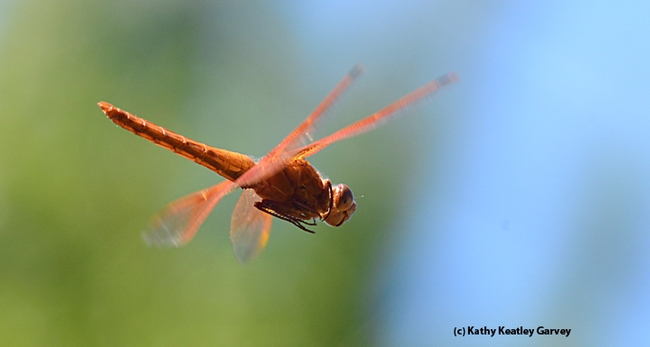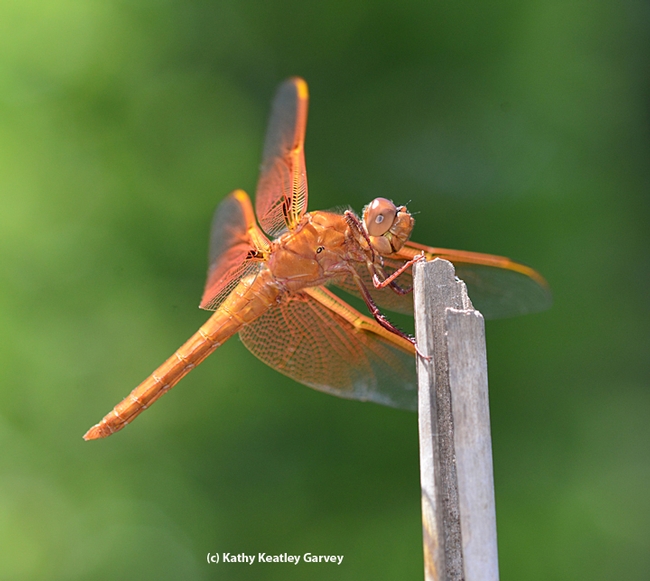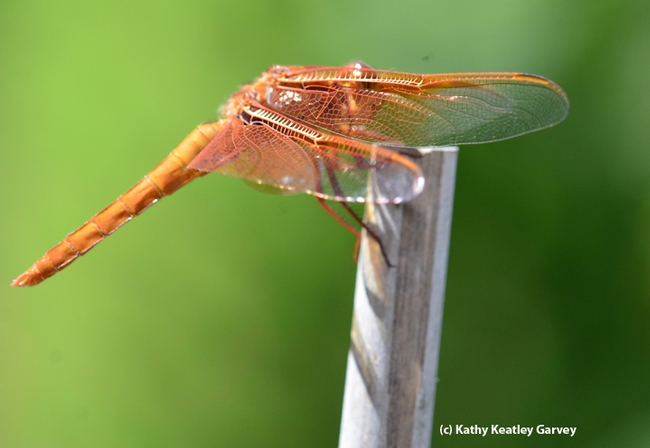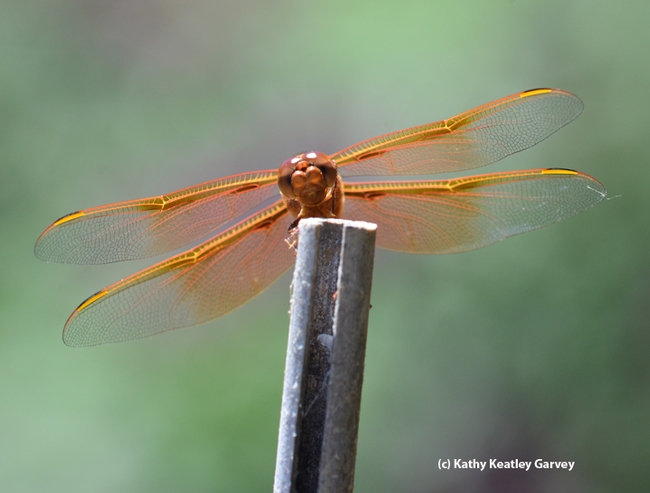It was windy enough to trigger a small craft advisory.
Yet here comes a flameskimmer dragonfly (Libellula saturata) around noon on Monday, Memorial Day, circling our little bee garden.
He chases a few flying insects around and then perches on a bamboo stake to eat them.
Hmm, I thought, maybe I can capture an image of Big Red in flight? Will he cooperate? I've always wanted to photograph a flameskimmer in flight, but they're usually (1) too fast (2) too far away or (3) they zig when I think they'll zag and they zag when I think they'll zig.
Plus, they are leery of big dark objects (cameras) with long metal protrusions (lenses).
For the past decade, we've prepared well for our dragonfly visitors. They like our fish pond, our bee garden and the assorted bamboo stakes we've placed around the garden. They especially like the all-you-can-eat insect smorgasbord.
Big Red kept returning to Bamboo Stake No. 2 (bamboo stakes are sort of like pot holes—you can name them if you want).
Using my Nikon D800 camera with a 200mm macro lens, I focused on where I thought Big Red would land.
Decision time.
Bamboo Stake No. 1: Probably not. Too high.
Bamboo Stake No. 3: No, a little short.
Bamboo Stake No. 2: Just right.
Big Red obliged. By now he was not afraid of me—he figured, and rightfully so--that I had no culinary interest in him. And neither would I poke 'em, prod 'em or pin 'em. With the wind tousling his wings, he aimed straight for Bamboo Stake No. 2.
Got 'em. In flight.
Said dragonfly aficionado Eric Mussen, Extension apiculturist emeritus: “What this photo really shows is that insects do not fly simply by ‘flapping' their wings. This guy's right wings are vertical to the body, but in the same plane, while the left wings actually are down-swept and a bit out of synchrony. The ability of insects to rotate their wings in their sockets allows them to change roll, pitch and yaw as do the moveable parts of airplanes. But, dragonflies can do it instantaneously.”
Commented Lynn Kimsey, director of the Bohart Museum of Entomology and professor of entomology at UC Davis: "I like how clearly you can see how tightly the one is holding its legs against its body."
The dragonfly vanished right before our residential scrub jays returned. The jays are rearing their young in nearby trees, and the young, as you know, get the munchies. In fact, they're always hungry. Ravenous. Famished.
Have you ever seen a bird nail a dragonfly? Butterflies, yes. Dragonflies, no.
“Birds can change direction in flight pretty quickly, but usually not quickly enough to catch a dragonfly in flight,” Mussen commented. “If it stays stuck to the post, it may be in real trouble.”
Attached Images:

Caught in flight: Flameskimmer dragonfly,Libellula saturata. (Photo by Kathy Keatley Garvey)

A flameskimmer dragonfly, Libellula saturata, perches on a bamboo stake. (Photo by Kathy Keatley Garvey)

Small craft advisory! A gust of wind tousles the wings of Big Red, the flameskimmer dragonfly. (Photo by Kathy Keatley Garvey)

A different view. Flameskimmer dragonfly on his bamboo perch. (Photo by Kathy Keatley Garvey)